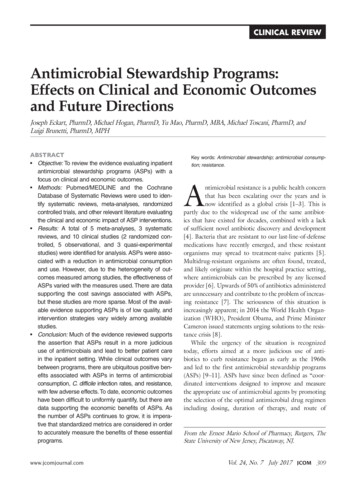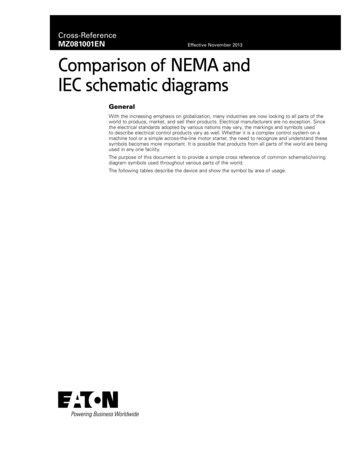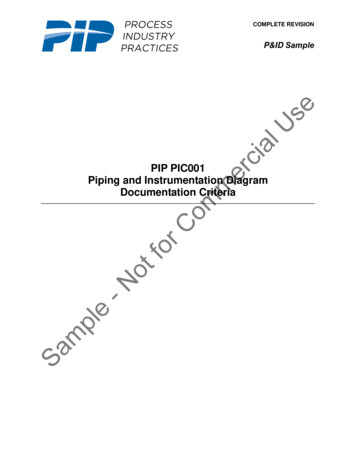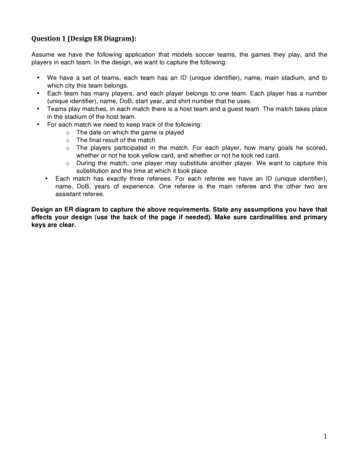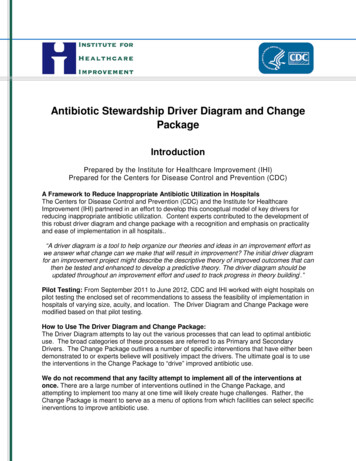
Transcription
Antibiotic Stewardship Driver Diagram and ChangePackageIntroductionPrepared by the Institute for Healthcare Improvement (IHI)Prepared for the Centers for Disease Control and Prevention (CDC)A Framework to Reduce Inappropriate Antibiotic Utilization in HospitalsThe Centers for Disease Control and Prevention (CDC) and the Institute for HealthcareImprovement (IHI) partnered in an effort to develop this conceptual model of key drivers forreducing inappropriate antibiotic utilization. Content experts contributed to the development ofthis robust driver diagram and change package with a recognition and emphasis on practicalityand ease of implementation in all hospitals.“A driver diagram is a tool to help organize our theories and ideas in an improvement effort aswe answer what change can we make that will result in improvement? The initial driver diagramfor an improvement project might describe the descriptive theory of improved outcomes that canthen be tested and enhanced to develop a predictive theory. The driver diagram should beupdated throughout an improvement effort and used to track progress in theory buildingi.”Pilot Testing: From September 2011 to June 2012, CDC and IHI worked with eight hospitals onpilot testing the enclosed set of recommendations to assess the feasibility of implementation inhospitals of varying size, acuity, and location. The Driver Diagram and Change Package weremodified based on that pilot testing.How to Use The Driver Diagram and Change Package:The Driver Diagram attempts to lay out the various processes that can lead to optimal antibioticuse. The broad categories of these processes are referred to as Primary and SecondaryDrivers. The Change Package outlines a number of specific interventions that have either beendemonstrated to or experts believe will positively impact the drivers. The ultimate goal is to usethe interventions in the Change Package to “drive” improved antibiotic use.We do not recommend that any facilty attempt to implement all of the interventions atonce. There are a large number of interventions outlined in the Change Package, andattempting to implement too many at one time will likely create huge challenges. Rather, theChange Package is meant to serve as a menu of options from which facilities can select specificinerventions to improve antibiotic use.
Selection of specific interventions to implement should be tailored to the areas that mostneed improvement at each facility. Facilities should assemble a multi-disciplinary team ofphysicians, pharmacists, nursing, microbiology and administration to discuss the aspects ofantibiotic use that are most in need of improvement. The team can then select specificinterventions from the Change Package to address those issues. It is important to select theinterventions that are most supported by clinical staff.It is essential to monitor and measure. The Driver Diagram and Change Package come witha Measurement Framework, which suggests various measures of antibiotic use that might beuseful to assess the effectiveness of improvements. Just as important is the measurement of“small tests of change” to assess the implementation of interventions. Reviews of smallnumbers of charts or discussions with clinicians can identify potential barriers to implementation.2July 2012 Update Antibiotic Stewardship Drivers and Change Package Prepared by the Institute for Healthcare Improvement
Antibiotic Stewardship Change Package3July 2012 Update Antibiotic Stewardship Drivers and Change Package Prepared by the Institute for Healthcare Improvement
Overarching Driver: Leadership and CultureSecondaryDriverPromote aculture ofoptimaliantibiotic usewithin the facility4Key ChangeConceptsEngageadministrative andclinical leadership tochampionstewardship effortSpecific Change Ideas1. Identify clinical providers as champions to be thought leaders aboutantibiotic stewardship.2. Work with administrators to ensure that they understand the rationaleand goals for stewardship programs and interventions so that they canprovide support (financial and non-financial).3. Engage a physician champion and core team to enhance the focus ofantimicrobial stewardship into the current process of care.4. Bring disciplines together to improve communication and collaborationabout improving antibiotic use, including, as appropriate: Infection preventionists; Hospitalists; Intensivists; Emergency department physicians; Microbiologists; Pharmacists; Nurses; and Infectious disease experts.5. Consider having the multidisciplinary group perform a gap analysis ofantimicrobial use at the facility to identify priority areas for improvement.July 2012 Update Antibiotic Stewardship Drivers and Change Package Prepared by the Institute for Healthcare Improvement
Primary Driver 1: Timely and Appropriate Initiation of AntibioticsSecondaryDriverPromptlyidentifypatients whorequireantibioticsKey ChangeConceptsDevelop astandardizedprocess toidentify patientswho requireantibioticsObtaincultures priorto startingantibioticsCreatestandardizedprotocols forordering andobtainingcultures andotherdiagnostic testsprior toinitiatingantibiotics5Specific Change Ideas1. Develop standardized diagnostic criteria for identifying patients with signs andsymptoms suggesting specific types of infection (e.g., community acquiredpneumonia (CAP), urinary tract infection (UTI), skin/soft tissue infection (SSTI),bloodstream infection (BSI), sepsis etc). These criteria should also clearly specifysituations when antibiotics are not indicated (e.g. non-infectious mimics of CAP).ii2. Develop evidence-based clinical pathways that guide diagnostic testing andtreatment for these common infections.3. Consider a computerized decision support system to enable physicians to identifywhich patients require antibiotics.1. Utilize prompts for obtaining cultures in automated medication dispensing systemsavailable in ED, ICU, etc.2. Develop processes to ensure cultures are properly and consistently ordered thatinclude: Prompts on antibiotic orders or physician order entry to remind users to obtainappropriate cultures; Culture prompts or default orders incorporated into standardized order sets forvarious conditions (e.g., CAP, UTI, SSTI, BSI); Guidance on appropriate specimen type and culture common infections (e.g.,CAP, UTI, SSTI, BSI); Guidance on frequently inappropriate culturing practices (e.g., swabs of wounds,urine cultures from asymptomatic patients).3. Develop processes to ensure cultures are properly and consistently obtained thatinclude: Protocols empowering/authorizing nursing staff to obtain cultures if otherproviders fail to order them when starting antibiotics; Guidance on appropriate specimen collection for specific indications (e.g.,number of blood cultures and volume of blood, cultures for anaerobic pathogens,rapid diagnostic tests); Visual cues in locations near antibiotic storage reminding staff to ensure cultureshave been obtained; Flags or other signal (at the bedside, in the electronic medical record (EMR), inthe chart) to make it apparent if cultures have not yet been obtained, andcheckboxes indicating that cultures have been obtained; A system to ensure cultures are obtained in patients transferred from theemergency department (ED) to the intensive care unit (ICU) or ward.4. Develop processes to ensure cultures are properly and promptly transported andprocessed.5. Develop standards for and assess reliability of processes for ordering and obtaininga culture for the following five steps: Appropriate specimen; Appropriate collection (i.e., before antibiotics were started); Appropriate labeling; Transport to lab (i.e., time from obtaining specimen to receipt in lab) Processing of specimen (i.e., time from receipt in lab to start of processing).July 2012 Update Antibiotic Stewardship Drivers and Change Package Prepared by the Institute for Healthcare Improvement
Primary Driver 1: Timely and Appropriate Initiation of AntibioticsSecondaryDriverKey ChangeConceptsSpecific Change IdeasDo not giveantibiotics withoverlappingactivity orcombinationsnot supportedby evidence orguidelinesDevelop a wayto informclinicians aboutunnecessarycombinations rmine andverifyantibioticallergies andtailor therapyaccordinglyChooseantibiotic basedon itypatterns inselectingtherapyDevelop astandardizedprocess forantibioticselection1. Develop a list of agents that should generally not be combined and develop amechanism for pharmacy to flag these combinations for review (e.g., doubleanaerobic coverage).2. Leverage the EHR with decision support at the point of care to trigger ABs withoverlapping activity or combinations not supported by GLs.3. Standardize a mechanism for review and follow-up of combinations of agents thatare not recommended.4. Develop evidence-based guidelines for the specific conditions in which combinationtherapy is recommended and what agents should be combined (based on localformulary and patterns of resistance). In general, use of combination therapy should be limited to empiric coverage ofmultiple drug resistant organisms (MDROs) prior to obtaining culture results.1. Consider patient allergies when initiating or changing therapy.2. Ensure that antibiotic allergies are obtained and documented in the medical record.Documentation should include the antibiotic and the type of reaction (e.g.,anaphylaxis, rash etc).3. Incorportate patient allergies as a required field in the EHR (ie: nursingassessment)4. Ensure antibiotic allergy history distinguishes true allergies that would preclude use(e.g., anaphylaxis) from adverse drug reactions (e.g., diarrhea). Involve patient and family in identifying and confirming allergies; Consider testing for beta-lactam allergy to confirm antibiotic allergy.6. Prominently flag medical record or computer order entry system to denote patientallergies to antibiotics.7. Standardize all hand offs to include assessment and review of patient allergies.1. Develop facility-specific guidance for diagnosing and treating infections and usingantibiotics. Consider starting with most commonly treated infections and/or most commonlyused antibiotics and most common treatment errors (e.g., when anaerobiccoverage is needed); Base the guidance on evidence as well as local susceptibility data and facilityformulary; Involve pharmacy and microbiology staff in developing and supporting antibioticselection guidance.2. Imbed facility-specific guidance in evidence-based clinical pathways and order sets.3. Utilize the EHR with clinical decision support functionality to support antibioticselection.4. Ensure that selection guidelines consider: Site of infection; Pharmacokinectics/dynamics of the agent Pathogen(s) that is the most likely cause of the infection being treated and itssusceptibility profile in the hospital and community; Toxicity; Potentially complicating comorbid conditions (e.g. renal dysfunction); Severity of the infection; Hospital formulary and cost.6July 2012 Update Antibiotic Stewardship Drivers and Change Package Prepared by the Institute for Healthcare Improvement
Primary Driver 1: Timely and Appropriate Initiation of AntibioticsSecondaryDriverKey ChangeConceptsSpecific Change IdeasConsiderlocalantibioticsusceptibilitypatterns yDevelop astandardizedprocess forantibioticselection(continued)5. For usual clinical scenarios in patients who are not critically ill, ensure that selectionguidelines target for the "norm," rather than for rare or unlikely events. Choose antibiotics with the narrowest spectrum and least cost possible.6. For critically ill patients, ensure that selection guidelines permit broad spectrumcoverage of antibiotic resistant pathogens based on local susceptibility patterns.7. Ensure facility guidelines make antibiotic susceptibility patterns and the cost ofantibiotics visible to clinicians at the point of care.Developprocesses thatsupport prompttreatment ofpatientsrequiringantibiotics1. Develop standard order sets/pathways for common infections that clearly specifyappropriate time from ordering to administration and monitor adherence to thesestandards. Consider signage in the chart or room to specify the time by which antibioticsmust be given.2. Develop a system for ensuring prompt treatment of patients transferred from the EDto the ICU or ward.3. Identify patients experiencing delays in antibiotic ordering and administration andassess and address delay-prone aspects of the system.4. Define a process to expedite decision making when attending physician is notimmediately available to order therapy.1. Follow the delivery chain from order to pharmacy and back again to ascertain whereefficiencies can be gained.2. Consider keeping frequently used antibiotics available in the ED and on the flooriv.Specifyexpectedduration oftherapy basedon evidenceand nationaland hospitalguidelines7Ensureantibiotics nes forduration ofantibiotics port1. Develop evidence-based clinical pathways that standardize the duration oftreatment.2. Permit physicians to opt out of the standard duration of treatment, but requiredocumentation of the rationalev.3. Consider a system for automatically discontinuing antibiotics based on national andfacility guidelines e.g. after 24 hours (surgical prophylaxis).4. Consider requiring re-ordering of antibiotics after a specified time period, e.g. 7-10days.5. Utilize the EHR with clinical decision support functionality to establish appropriateduration.6. Reassess the need for and prescribed duration of antibiotics daily and at alltransitions in care.July 2012 Update Antibiotic Stewardship Drivers and Change Package Prepared by the Institute for Healthcare Improvement
Primary Driver 2: Appropria
Reviews of small numbers of charts or discussions with clinicians can identify potential barriers to implementation. 2 . July 2012 Update Antibiotic Stewardship Drivers and Change Package Prepared by the Institute for Healthcare Improvement .



